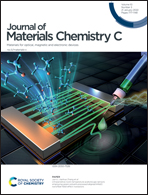Controlling the excited-state relaxation for tunable single-molecule dual fluorescence in both the solution and film states†
Abstract
Realizing single-molecule dual fluorescence with facile tunability in both the solution and film states through manipulation of the excited-state relaxation pathways is highly desirable but challenging. Herein, three synthesized fluorophores emit dual fluorescence originating from two excited-state intramolecular proton transfer tautomers. Their emission behaviors in the solution and film states are controlled by the excited-state kinetics and thermodynamics, and adjusted by the targeted chemical modification. Notably, the dual fluorescence of the methoxyl substituted molecule can be regulated via controlling the excited-state relaxation with the different excitation wavelengths. We found that the resulting twisted configuration in the S2 state providing an additional pathway to yield the phototautomer is responsible for the modulating mechanism in the solution, while the proton transfer occurs in the S2 state through suppression of S2 → S1 internal conversion for that in the film state.



 Please wait while we load your content...
Please wait while we load your content...